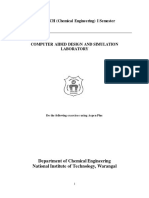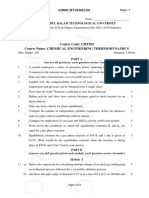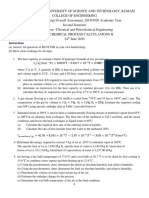Thapar University, Patiala
Thapar University, Patiala
Uploaded by
sahibjotCopyright:
Available Formats
Thapar University, Patiala
Thapar University, Patiala
Uploaded by
sahibjotOriginal Title
Copyright
Available Formats
Share this document
Did you find this document useful?
Is this content inappropriate?
Copyright:
Available Formats
Thapar University, Patiala
Thapar University, Patiala
Uploaded by
sahibjotCopyright:
Available Formats
Thapar University, Patiala
Department of Chemical Engineering
Name Roll No
BE-Chemical Engineering (III/End UCH-303: Chemical Engineering Thermodynamics
Semester)
Time: 3.0 hr; MM: 50 Name of Faculty: Dr. Haripada Bhunia
Note: Attempt all questions. Draw the sketches neatly. Physical data, steam table, etc. are
allowed. Assume suitable data, if required.
Q1 Ethanol (1)/ benzene (2) system forms an azeotrope with 44.8 mol % ethanol
with a boiling point of 68.24 C at 760 Torr. The saturation pressures of ethanol
(1) and benzene (2) at 68.24 C are 506 Torr and 517 Torr, respectively. 5+5=10
Estimate the van Laar constants for the system and evaluate the activity
coefficients for a solution containing 10 mol% ethanol.
Q2. An experimental determination of vapour liquid equilibrium state of ether (1) and
acetone (2) binary system gave the following result:
x1= 0.3, yi = 0.3, T = 40C, and P= 105 Pa. The saturation vapour pressures of
5+3=8
the pure components at 40C are ether (1) = 1.21x105 Pa; acetone (2) =
0.56x105 Pa.
(i) Calculate the liquid phase activities coefficients.
(ii) What is the value of excess Gibbs free energy GI' for the liquid phase?
T
Q3. Develop expression for the mole fraction of reacting species as function cf the
reaction coordinate for a system initially containing 2 mol NH3 and 5 mol 02 and 5
undergoing the reaction:
4NH3 (g) + 502 (g) 4NO (g) + 6H20 (g)
Q4. Derive and calculate the fugacity of CO2 gas at 100 atm pressure and 75C
assuming that the gas obeys van der Waals equation of state. The constants 5+2=7
for this equation of state are:
a =3.606x106 cam.cc gmol 2 b = 42.88cc / gmol
Q5. Under what circumstance the property change of mixing and the excess
properties are identical? Prove that activity coefficient and excess Gibbs energy 2+3=5
are correlated.
Q6 Estimate the fugacity of liquid acetone at 110C and 275 bar. At 110C the
vapour pressure of acetone is 4.36 bar and the molar volume of liquid acetone 5
is 73 cm3/mol.
Q7. Derive a relation to estimate the equilibrium constant from a knowledge of the 5
standard Gibbs free energy change of a chemical reaction.
Q8. A Carnot refrigerator is used to maintain a food compartment at -4 C. Heat is
released from the compartment to a room at 30 C. If 30 kW heat is removed, 2+3=5
determine (a) the coefficient of performance of the cycle and (b) the rate of
heat released to the room.
Please see your evaluated answer booklet on 10/12/2014 at 11.30 AM in CRE Lab.
You might also like
- CH Be 3110 ProblemsDocument75 pagesCH Be 3110 ProblemsAnkit DhalNo ratings yet
- Uhu081 PDFDocument2 pagesUhu081 PDFsahibjotNo ratings yet
- Carrier Bus Air Conditioning Rearmount 68RM35-604-20 (R134a) Operation&Service Manual (NYCDOT) Pub#T288Document45 pagesCarrier Bus Air Conditioning Rearmount 68RM35-604-20 (R134a) Operation&Service Manual (NYCDOT) Pub#T288Clifton Jamison60% (5)
- ExercisesDocument13 pagesExercisesRajpriya GuptaNo ratings yet
- Final Exam - January 2011Document2 pagesFinal Exam - January 2011Hazem MohamedNo ratings yet
- Gujarat Technological UniversityDocument2 pagesGujarat Technological Universityyicef37689No ratings yet
- IV B. TECH (Chemical Engineering) I SemesterDocument14 pagesIV B. TECH (Chemical Engineering) I SemesterPiyush AmbulgekarNo ratings yet
- Prepa 3035Document4 pagesPrepa 3035michelakon1No ratings yet
- BCT Important QuestionDocument5 pagesBCT Important QuestionliaayeongNo ratings yet
- Cet IiDocument4 pagesCet IiAnanya DaveNo ratings yet
- r05310803 Chemical Engineering Thermodynamics IIDocument8 pagesr05310803 Chemical Engineering Thermodynamics IISrinivasa Rao GNo ratings yet
- 2021 July CHT202-ADocument3 pages2021 July CHT202-AAkshay A BijuNo ratings yet
- Chapter 1-3Document22 pagesChapter 1-3Aiman LatifNo ratings yet
- Sample Exam Paper - PC (2130504) Winter 2019 Midsem Sem.Document2 pagesSample Exam Paper - PC (2130504) Winter 2019 Midsem Sem.Priyank KhirsariyaNo ratings yet
- Thermodynamics Question SetDocument10 pagesThermodynamics Question SetMaharghya BiswasNo ratings yet
- Thermo QualsDocument26 pagesThermo QualsLuc LeNo ratings yet
- CH en 6853 - Graduate Che Thermodynamics - Fall 2016 Homework #5Document3 pagesCH en 6853 - Graduate Che Thermodynamics - Fall 2016 Homework #5Md Faisal KarimNo ratings yet
- Chemical Thermodynamics Class 12th Practice PaperDocument8 pagesChemical Thermodynamics Class 12th Practice PaperLiyutsa ZirangeNo ratings yet
- Mid Term Exam November 2011Document4 pagesMid Term Exam November 2011Beatriz IzquierdoNo ratings yet
- Thermodynamics TutorialDocument2 pagesThermodynamics TutorialMuhamad Hazim Zaaba0% (1)
- Equilibrium Constants Methyl Tert-Butyl Ether Liquid-Phase SynthesisDocument5 pagesEquilibrium Constants Methyl Tert-Butyl Ether Liquid-Phase Synthesisjulior87No ratings yet
- B18pa1 NHN 08 PDFDocument4 pagesB18pa1 NHN 08 PDFMohamed AbdullaNo ratings yet
- Part B & Part C Questions: Bt8302 Applied Thermodynamics For BiotechnologistsDocument1 pagePart B & Part C Questions: Bt8302 Applied Thermodynamics For BiotechnologistsKathir Vel.kNo ratings yet
- SLab 2022 Internal QPDocument4 pagesSLab 2022 Internal QPChemical StudentsNo ratings yet
- Nptel Mto.2 DistillationDocument3 pagesNptel Mto.2 Distillationmaddukuri jagadeesh babuNo ratings yet
- Overall Assessment CHE 252 2020Document3 pagesOverall Assessment CHE 252 2020Enoch AffulNo ratings yet
- Vapor Pressure and Fugacity Solved ProblemsDocument26 pagesVapor Pressure and Fugacity Solved ProblemsPhumla MagagulaNo ratings yet
- Ki KBR H C Ki BR H C: Oducts B ADocument2 pagesKi KBR H C Ki BR H C: Oducts B AnaverfallNo ratings yet
- SCH 201..Document3 pagesSCH 201..jipson olooNo ratings yet
- Chemistry TestDocument12 pagesChemistry TestKimmy KuoNo ratings yet
- Isobaric Vapor Liquid Equilibria of The Water 2-Propanol System at 30, 60, and 100 KpaDocument4 pagesIsobaric Vapor Liquid Equilibria of The Water 2-Propanol System at 30, 60, and 100 KpaRafael HenriqueNo ratings yet
- Exam 2 Materialsand Energy BalancesDocument2 pagesExam 2 Materialsand Energy BalancesFiel A'nNo ratings yet
- rr310802 Chemical Engineering Thermodynamics IIDocument8 pagesrr310802 Chemical Engineering Thermodynamics IISRINIVASA RAO GANTANo ratings yet
- Elizalde Solis2005Document6 pagesElizalde Solis2005jasontodd22031995No ratings yet
- (P01, C01, C02, C2, C3) : Confidential EH/JUN 2014/CHE584/594Document11 pages(P01, C01, C02, C2, C3) : Confidential EH/JUN 2014/CHE584/594Addison JuttieNo ratings yet
- ThermoII Exercise 1Document53 pagesThermoII Exercise 1Batuhan KalyoncuNo ratings yet
- Test 1 PhysChem - May 2022 - W - AnsDocument5 pagesTest 1 PhysChem - May 2022 - W - Ansmarc jacobs davisNo ratings yet
- Cet IiDocument2 pagesCet IiVivek ParmarNo ratings yet
- 52194Document2 pages52194Praveen KumarNo ratings yet
- Assignment 01Document2 pagesAssignment 01Rashmi SahooNo ratings yet
- Exam CEMI313 June 21 2012 With AnswersDocument7 pagesExam CEMI313 June 21 2012 With AnswersReaper0007No ratings yet
- Exam I - SolutionsDocument34 pagesExam I - Solutionshy2023056744No ratings yet
- Gujarat Technological UniversityDocument2 pagesGujarat Technological Universityvyomjavia092003No ratings yet
- 2023 MteDocument6 pages2023 MteISHAAN JAIN 22114039No ratings yet
- 10.213 Chemical Engineering Thermodynamics Spring 2002 Problem Set DDocument2 pages10.213 Chemical Engineering Thermodynamics Spring 2002 Problem Set DPM SHNo ratings yet
- Cet Endsem PQDocument2 pagesCet Endsem PQBT20CME033 Gautam TahilyaniNo ratings yet
- Anna University :: Chennai - 600 025Document2 pagesAnna University :: Chennai - 600 025NandhanNo ratings yet
- CH1201 2019 EndSemesterDocument1 pageCH1201 2019 EndSemesterSourasish DasNo ratings yet
- Department of Chemical Engineering National Institute of Technology RourkelaDocument1 pageDepartment of Chemical Engineering National Institute of Technology RourkelaAbhisek AgarwalNo ratings yet
- Deber FiscioDocument3 pagesDeber FiscioEstefy LaglaNo ratings yet
- Set 2 SonDocument4 pagesSet 2 SonJerson Mendoza CNo ratings yet
- ThermoDocument9 pagesThermoFaizan AhmedNo ratings yet
- Chemistry 1 Thermodynamics Final and SolutionsDocument11 pagesChemistry 1 Thermodynamics Final and SolutionsFair PisuttisarunNo ratings yet
- Samp Chem 3Document2 pagesSamp Chem 3Dhruv GoyalNo ratings yet
- 3 SEM/ Chemical Engineering / 2020 (W) NEW Th4 Industrial StoichiometryDocument2 pages3 SEM/ Chemical Engineering / 2020 (W) NEW Th4 Industrial StoichiometrySushanta K BeheraNo ratings yet
- Chemistry 122 Kinetics and Equilibrium Exam ReviewDocument12 pagesChemistry 122 Kinetics and Equilibrium Exam ReviewKyle GeryczNo ratings yet
- Assignment 1 PDFDocument1 pageAssignment 1 PDFRoydia SimanNo ratings yet
- Che3161 Solutions 2009Document39 pagesChe3161 Solutions 2009Daryl LeeNo ratings yet
- Exercice SDocument43 pagesExercice SLuis Alberto Follegatti RomeroNo ratings yet
- A Modern Course in Statistical PhysicsFrom EverandA Modern Course in Statistical PhysicsRating: 3.5 out of 5 stars3.5/5 (2)
- Thapar University, Patiala: Instruction: Attempt All Question in Proper Sequence. Assume Missing Data (If Any) - Q.1Document2 pagesThapar University, Patiala: Instruction: Attempt All Question in Proper Sequence. Assume Missing Data (If Any) - Q.1sahibjotNo ratings yet
- Uhu081 PDFDocument2 pagesUhu081 PDFsahibjotNo ratings yet
- Thapar Institute of Engineering and TechnologyDocument2 pagesThapar Institute of Engineering and TechnologysahibjotNo ratings yet
- Uhu081 PDFDocument2 pagesUhu081 PDFsahibjotNo ratings yet
- Thapar University, Patiala Department of Chemical EngineeringDocument2 pagesThapar University, Patiala Department of Chemical EngineeringsahibjotNo ratings yet
- Worksite Hazard Analysis: Presented By: Thomas Dean Georgia TechDocument113 pagesWorksite Hazard Analysis: Presented By: Thomas Dean Georgia TechsahibjotNo ratings yet
- Convincing Parents To Send Their Girl Child ForDocument17 pagesConvincing Parents To Send Their Girl Child ForsahibjotNo ratings yet
- Super PhosphateDocument25 pagesSuper Phosphatesahibjot100% (1)
- Thapar University, Patiala Department of Chemical EngineeringDocument2 pagesThapar University, Patiala Department of Chemical EngineeringsahibjotNo ratings yet
- 2johari WindowDocument13 pages2johari WindowsahibjotNo ratings yet
- Num Math PDFDocument87 pagesNum Math PDFsahibjotNo ratings yet
- 7 - Sulfur & Sulfuric Acid TaughtDocument58 pages7 - Sulfur & Sulfuric Acid TaughtsahibjotNo ratings yet
- Set 2Document18 pagesSet 2RON MARK EDWARD ANDALUZNo ratings yet
- Perancangan Sistem Refrigerasi Untuk Blast Freezer Pada Kapal Ikan 200 GTDocument6 pagesPerancangan Sistem Refrigerasi Untuk Blast Freezer Pada Kapal Ikan 200 GTaziz ilmanudinNo ratings yet
- Sample QuestionsDocument2 pagesSample QuestionsnakatsuswanNo ratings yet
- List of Alarms Climatic 620 MW324004Document6 pagesList of Alarms Climatic 620 MW324004abdenourNo ratings yet
- Presentation 1Document19 pagesPresentation 1Asim FarooqNo ratings yet
- Steam Table PDFDocument21 pagesSteam Table PDFDarshan100% (1)
- ComCheck Efficiency OptionsDocument5 pagesComCheck Efficiency OptionsBorkoBGNo ratings yet
- CHE-314: Lecture 4. Section 2: The Heat Diffusion Equation and Transport PropertiesDocument26 pagesCHE-314: Lecture 4. Section 2: The Heat Diffusion Equation and Transport PropertiesAkib ImtihanNo ratings yet
- Temperature Measurement Devices LMSDocument13 pagesTemperature Measurement Devices LMSshokishazadaNo ratings yet
- AFRC - Improving Performance of Coker HeatersDocument29 pagesAFRC - Improving Performance of Coker Heatersashutosh_garg_10No ratings yet
- Hot Water Heat Pump DesignDocument3 pagesHot Water Heat Pump DesignAdhikar HariramNo ratings yet
- DHIRDocument6 pagesDHIRImaneNo ratings yet
- Floor Standing Type Air Conditioner: Service ManualDocument51 pagesFloor Standing Type Air Conditioner: Service ManualAshish DixitNo ratings yet
- Honda Civice 023-03 HvacDocument58 pagesHonda Civice 023-03 Hvactong SaetungNo ratings yet
- Questions With Solutions Mid-Sem FinalDocument7 pagesQuestions With Solutions Mid-Sem FinalAshNo ratings yet
- How To Save Energy in Refrigeration PDFDocument67 pagesHow To Save Energy in Refrigeration PDFcyclon2010100% (1)
- Fast Evaluation of Thermodynamic Properties of Superheated Steam A Cubic Equation of StateDocument9 pagesFast Evaluation of Thermodynamic Properties of Superheated Steam A Cubic Equation of StateShalehAhmad100% (1)
- T E - Assig Q'sDocument2 pagesT E - Assig Q'sDinesh PaudelNo ratings yet
- Air CompressorsDocument2 pagesAir CompressorsBrandy Ponting SusonNo ratings yet
- Lee & Mudawar 2008 Fluid Flow and Heat Transfer Characteristics of Low Temperature Two Phase Microchannel Heat Sink - P2Document15 pagesLee & Mudawar 2008 Fluid Flow and Heat Transfer Characteristics of Low Temperature Two Phase Microchannel Heat Sink - P2Chong Jen HawNo ratings yet
- Summary of Thermal Load Calculation and Electrical Demand For A/C Units and LightDocument3 pagesSummary of Thermal Load Calculation and Electrical Demand For A/C Units and Lightsiva anandNo ratings yet
- 0300 Function of The Residual Engine Heat Utilization System Model 124Document4 pages0300 Function of The Residual Engine Heat Utilization System Model 124Ognjen GalićNo ratings yet
- Q1-WW in Gen Chem 2Document3 pagesQ1-WW in Gen Chem 2Jenny Vhie S. VinagreraNo ratings yet
- UP TGT PGT Heat and Thermodynamics TEST SERIESDocument161 pagesUP TGT PGT Heat and Thermodynamics TEST SERIESSuresh ShahNo ratings yet
- Determination of Partition Coefficient of Iodine in Water and Carbon Tetra ChlorideDocument15 pagesDetermination of Partition Coefficient of Iodine in Water and Carbon Tetra ChlorideNanda Satish100% (1)
- Ayvaz Valve Insulation JacketsDocument5 pagesAyvaz Valve Insulation JacketsmkaddyNo ratings yet
- Tank Venting Requirements (API 2000) 2Document3 pagesTank Venting Requirements (API 2000) 2RubensBoerngenNo ratings yet
- 5 Stage Reciprocating CompressorDocument10 pages5 Stage Reciprocating CompressorJhay-Pee QueliopeNo ratings yet
- Ciat NA19679A-Dynaciat-power-1Document30 pagesCiat NA19679A-Dynaciat-power-1Trevor DannNo ratings yet






































































































